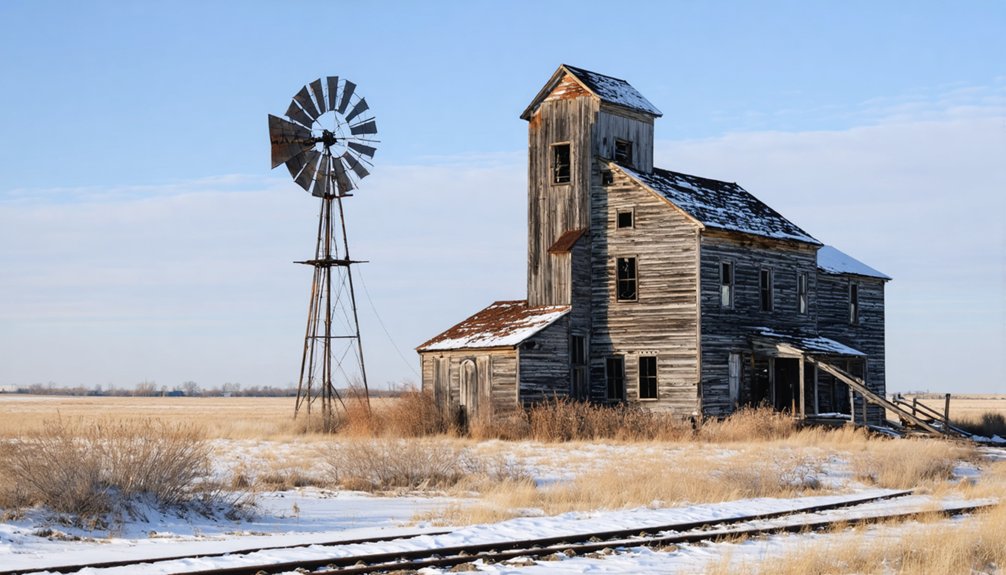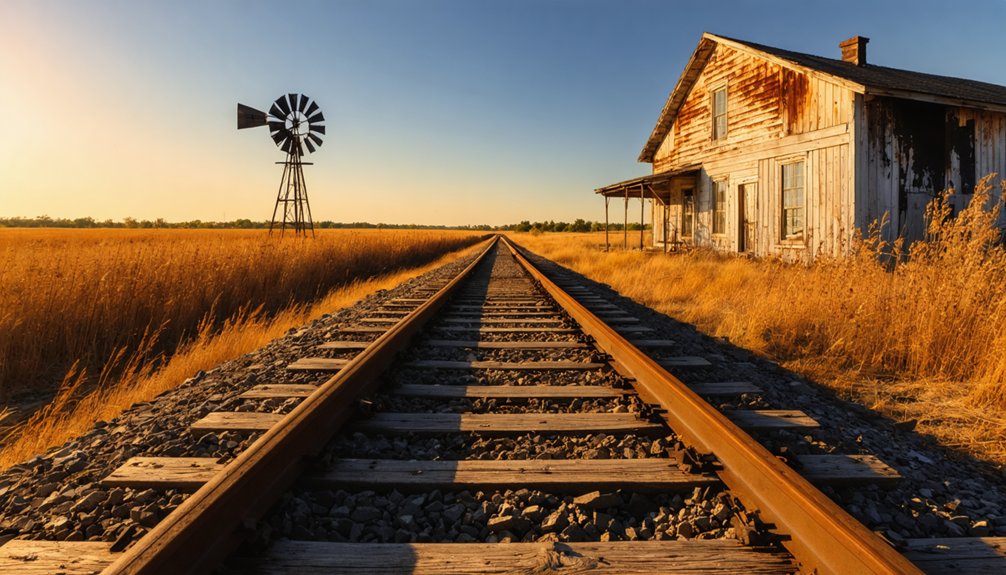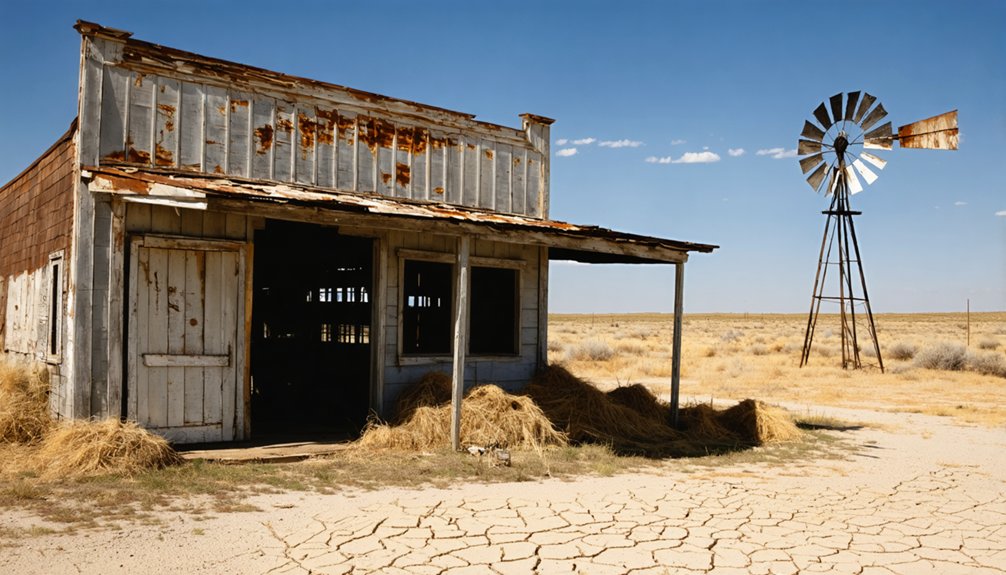You’ll find Gray Mule’s ghost town remains in the Texas Panhandle, where it once flourished as an essential railroad stop after 1877. The town became a bustling agricultural hub with cotton processing, a schoolhouse, and a baseball diamond during its 1920s peak. Following World War II, the community declined as younger residents left for urban opportunities and road development favored other towns. The old railroad stop’s quiet ruins hold fascinating stories of Texas’ railroad golden age.
Key Takeaways
- Gray Mule emerged as a significant railroad stop in Texas during the late 1800s, serving agricultural and ranching operations.
- The town flourished in the 1920s with a vibrant community centered around cotton processing and railroad activities.
- Community facilities included a schoolhouse, baseball diamond, blacksmith shop, and the Starlight Theatre for local entertainment.
- Agricultural operations featured diverse farming with cotton, wheat, and grain sorghum, supported by integrated cattle ranching.
- Post-World War II population shifts, geographic isolation, and improved roads elsewhere led to Gray Mule’s eventual abandonment.
The Rise of a Railroad Stop
As the St. Louis Southwestern Railway began transforming the Southwest in 1877, railroad development across Texas created opportunities for strategic stops like Gray Mule.
You’ll find this Panhandle settlement’s story intertwined with the region’s expanding rail network, which started with just one locomotive and minimal infrastructure but quickly grew to serve the booming cattle industry.
The economic impact of rail access proved essential for the Texas Panhandle, where Gray Mule emerged as a key point along routes that connected ranching operations, including those of Charles Goodnight and John Adair. The area saw significant growth when the Panhandle & Santa Fe established operations in 1914, bringing new transportation opportunities to the region.
Rail access transformed Gray Mule into a vital Panhandle hub, linking major ranching operations and driving regional economic growth.
Like many railroad stops of its era, Gray Mule benefited from the railway companies’ push to establish affordable transportation models, which helped the Southwest’s economy recover from post-Civil War depression. The railway’s development faced significant hurdles during the economic depression of 1876, making it challenging for early operators to secure necessary funding through stock sales.
Life in Gray Mule’s Heyday
If you’d visited Gray Mule during its peak in the 1920s, you’d have found a bustling railroad stop where local farmers brought their cotton to be processed at the community gin.
The steam locomotive trains would make regular stops to replenish their water supply at this vital waypoint.
You could’ve joined residents gathering at the baseball diamond for weekend games or watched children playing outside the schoolhouse during recess.
Like many one-room schoolhouses across the Texas Panhandle, Gray Mule’s school served as both an educational center and a gathering place for community events.
The blacksmith’s hammer would’ve rung out daily as he repaired farming equipment and shod horses, while wagons loaded with cotton made their way to and from the railroad station.
Railroad Hub Activities
During its heyday, Gray Mule thrived as an essential railroad hub where regional and national rail networks converged to exchange freight and passengers.
You’d have seen bustling freight logistics operations handling cotton, livestock, and timber shipments, with warehouses lining the tracks for temporary storage and sorting. The Irish immigrants made up much of the unskilled labor force maintaining the rail lines and loading cargo.
The town’s passenger services included regular stops, ticket offices, and basic amenities for travelers passing through.
The railroad yard buzzed with activity as maintenance crews serviced locomotives and railcars, while telegraph operators coordinated train movements from the dispatch center.
You’d have found crew change points where engineers and conductors swapped shifts, along with resting facilities for railroad workers.
The economic impact reached beyond the tracks, as local businesses, from general stores to blacksmith shops, flourished by serving the steady stream of railroad traffic.
Today, railroad enthusiasts can explore similar historic transportation at the Texas Transportation Museum in San Antonio.
Community Gathering Places
Life in Gray Mule centered around several key gathering places that shaped the town’s social fabric in the 1920s. The schoolhouse hosted school events and community meetings, while the baseball diamond drew crowds for games and outdoor celebrations.
You’d find residents catching up on local news at the blacksmith shop or attending services at nearby churches like Carr’s Chapel. Like the historic town of Sweet Home, Gray Mule was established by former slaves seeking to build their own thriving community.
Community picnics and seasonal festivals brought everyone together, often held on the school grounds or near the baseball field. These gatherings helped fight the isolation of rural life and strengthened bonds between neighbors, similar to the Carr’s Chapel congregation that gathered for photographs in 1914.
The Gray Mule Cemetery, still standing today, served as a place for spiritual reflection and remembrance, connecting residents to their shared heritage and those who came before them.
Agricultural Business Operations
While most East Texas towns relied on a single cash crop, Gray Mule’s agricultural success stemmed from its diverse farming operations in the 1920s.
You’d find a thriving mix of crop diversification and livestock management that set the community apart. Local farmers mastered the art of rotating cotton, wheat, and grain sorghum to maintain soil health while maximizing profits. Like many communities during westward expansion, Gray Mule’s farmers embraced innovative agricultural methods to establish their foothold in Texas. The Keisling cotton gin served as a crucial processing facility for the area’s cotton production.
The backbone of Gray Mule’s agricultural strength included:
- Strategic cotton ginning operations connected to local mills and storage facilities
- Integrated ranching operations where cattle grazed between crop fields
- Railroad access for shipping agricultural products to regional markets
You’d see farmers adapting to seasonal rhythms, moving from winter wheat harvests to summer cotton cultivation, while managing their livestock year-round.
This balanced approach helped sustain Gray Mule’s economy through changing market conditions.
Agricultural Heritage and Cotton Production
You’d find Gray Mule’s cotton gin operating at full capacity during the 1920s peak seasons, when local farmers brought their harvests from fields worked by both mule teams and seasonal laborers.
The gin’s steady hum would accompany the rhythmic loading and unloading of cotton wagons, while farmhands and gin workers processed the region’s white gold using machinery that separated seeds from fiber.
Throughout the picking season, which typically ran from August through November, the farming community’s daily life revolved around cotton production, with families working together to bring in the harvest before winter arrived.
Cotton Gin Operations
During its heyday in the early 1930s, Gray Mule’s cotton gin anchored the town’s agricultural economy alongside its store and blacksmith shop. The gin technology had evolved from mule-powered operations to mechanized systems, dramatically improving efficiency and economic impact on the local community.
You’d find the gin humming with activity during harvest seasons, processing local farmers’ cotton into marketable bales.
Key aspects of Gray Mule’s cotton gin operations included:
- Seasonal processing cycles aligned with spring and early summer harvests
- Creation of compact cotton bales ready for textile manufacturing or sale
- Serving as a community hub where farmers gathered during ginning season
The gin’s presence helped sustain Gray Mule’s commercial infrastructure, connecting local farmers to regional and national cotton markets until broader economic shifts affected small-town gin operations.
Farming Community Life
As fertile blackland prairies supported Gray Mule’s agricultural foundation, the community thrived on diverse farming operations that stretched beyond cotton production.
You’d find families working together on mixed farms, cultivating not just cotton but also corn, beans, and hay. Their farming practices reflected a deep understanding of the land, incorporating crop rotation to maintain soil health and maximize yields.
Life centered around seasonal rhythms, with community celebrations marking successful harvests and important milestones.
You’d see mules and oxen helping with heavy farm work, while crosscut saws cleared new land for planting.
Local markets and family-run stores formed the backbone of trade, where farmers sold their diverse crops.
The tight-knit community shared resources and labor, creating a resilient network that sustained Gray Mule’s agricultural heritage through challenging times.
Seasonal Harvest Practices
The cotton harvest defined the seasonal rhythm of life in Gray Mule, transforming the community into a bustling hub of activity from August through October.
You’d find farmers and laborers preparing fields meticulously, clearing weeds to guarantee peak cotton quality before the intensive picking began. As labor shortages grew, many local farmers relied on Mexican-American workers to supplement their workforce.
Here’s how the harvest typically unfolded:
- Pre-harvest field preparation with mule-drawn plows
- Cotton picking by hand, moving systematically from early to late-maturing fields
- Post-harvest activities including gathering stalks for fodder and field preparation
The success of each harvest deeply impacted Gray Mule’s economic stability, with cotton serving as the primary cash crop that sustained the community’s livelihood through market sales and sharecropping arrangements.
Community Landmarks and Social Life
Life in Gray Mule centered around several key military and civilian structures that formed the heart of this historic Texas settlement.
You’ll find the military heritage reflected in four officers’ quarters, four enlisted barracks, and support facilities like the quartermaster’s store and hospital. These buildings created a self-sufficient community where both soldiers and civilians thrived.
The town’s social traditions came alive in gathering spots like the saloon and company stores, where residents shared supplies, stories, and camaraderie.
In the heart of Gray Mule, local bonds formed over whiskey and tales shared at bustling saloons and supply stores.
The Starlight Theatre hosted entertainment events, while community celebrations like Day of the Dead observances by candlelight brought people together.
Today, you can still explore remnants of these landmarks, from the weathered jail to the boot hill cemetery, where marble tombstones tell personal stories of Gray Mule’s past.
The Decline of a Panhandle Town

While steam trains initially fueled Gray Mule’s growth as an essential water stop, shifting transportation trends in the mid-20th century triggered the town’s steady decline. The town’s lack of economic resilience became evident as its cotton-based economy struggled with market changes and agricultural mechanization.
Three key factors accelerated Gray Mule’s transformation into a ghost town:
- The closure of crucial community infrastructure, including the schoolhouse and blacksmith shop
- Population shifts as younger residents left for urban opportunities, especially after World War II
- Geographic isolation below the Caprock Escarpment, which limited expansion possibilities
The town’s position near Long Hollow Creek couldn’t sustain its earlier promise, and development of roads favoring other communities sealed Gray Mule’s fate.
As local services vanished, so did the remaining residents, marking the end of this once-thriving Panhandle settlement.
Remnants and Historical Traces
Today, scattered remnants of Gray Mule’s brief existence dot the windswept Panhandle landscape, telling a story of frontier ambition and agricultural prosperity.
You’ll find the foundations of a cotton gin and blacksmith shop, while archaeological findings reveal metal fragments and weathered stone walls marking where buildings once stood. The town’s layout remains visible through sparse vegetation patterns and soil variations that outline former roads and building plots.
The most significant remnant is the Gray Mule Cemetery, where well-preserved headstones from the early 1900s provide essential genealogical information about the town’s pioneers.
While the schoolhouse has crumbled to ruins and no original buildings remain standing, you can still trace the community’s footprint along Long Hollow Creek, where the land’s natural contours once supported a strategic railroad water stop.
Legacy in Texas Railroad History

Although Gray Mule’s physical structures have largely vanished, the town’s significance in Texas railroad history endures through its role in the Cotton Belt line’s strategic expansion.
You’ll find Gray Mule’s story woven into the broader pattern of railroad-driven development that transformed northeast Texas in the late 19th and early 20th centuries.
Key aspects of Gray Mule’s railroad legacy include:
- The town’s connection to the Texas and St. Louis Railway’s ambitious plan to link major regional hubs like Mount Pleasant, Tyler, and Waco.
- Its role in the systematic town relocation movement that saw communities gravitating toward rail lines for economic survival.
- The direct impact of the Cotton Belt route on Collin County’s development, which created a network of interdependent commercial centers.
These railway influences shaped Gray Mule’s rise and eventual decline.
Frequently Asked Questions
How Did Gray Mule Get Its Unusual Name?
While you’ll find Gray Mule’s origin story isn’t definitively documented, local folklore suggests it’s linked to a notable gray mule used in the area’s farming or railroad operations during early settlement.
Are There Any Known Photographs of Gray Mule During Its Peak?
You’ll find historic imagery of this ghost town mainly through two key photographs of the Grey Mule Saloon, preserved by the University of North Texas Libraries, plus some 1930s shots of surrounding buildings.
What Happened to the Original Residents After Abandoning Gray Mule?
After leaving the ghost town, original residents moved to larger nearby communities like Floydada, seeking better jobs and services. They adapted by farming, taking railroad jobs, or starting new businesses elsewhere.
Can Visitors Legally Explore the Gray Mule Site Today?
You’ll need landowner permission to legally explore the site, as visitor access is restricted by private property laws. The cemetery may have different exploration rules, but verify before visiting.
Were There Any Notable Crimes or Mysteries Associated With Gray Mule?
You won’t find any documented unsolved mysteries or ghostly sightings in this town’s history. Records show it was a quiet farming community that declined due to economic factors, not criminal activity.
References
- https://www.amarillo.com/story/news/local/2014/06/13/panhandle-ghost-towns-hang-through-history/13269310007/
- https://discovertexasoutdoors.com/places/gray-mule/
- https://www.texasescapes.com/TexasGhostTowns/Gray-Mule-Texas-Old-Photos.htm
- https://en.wikipedia.org/wiki/List_of_ghost_towns_in_Texas
- https://www.davickservices.com/floyd_county_1905-1947.htm
- https://www.texasescapes.com/TexasGhostTowns/Gray-Mule-Texas.htm
- https://ttarchive.com/Library/Articles/Cotton-Belt_80-Years-Progress.html
- http://txrrhistory.com/towers/212/212.htm
- https://www.txtransportationmuseum.org/newpagefa9a7ba2
- https://tpwmagazine.com/archive/2005/nov/threedays/



